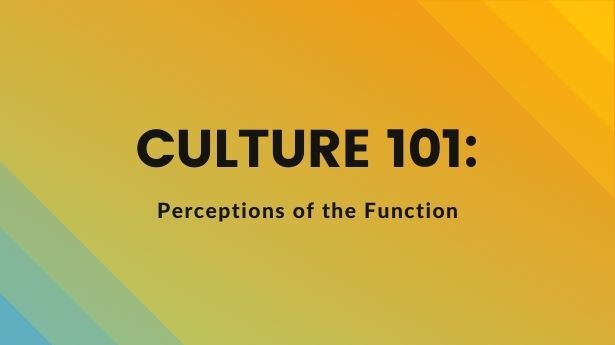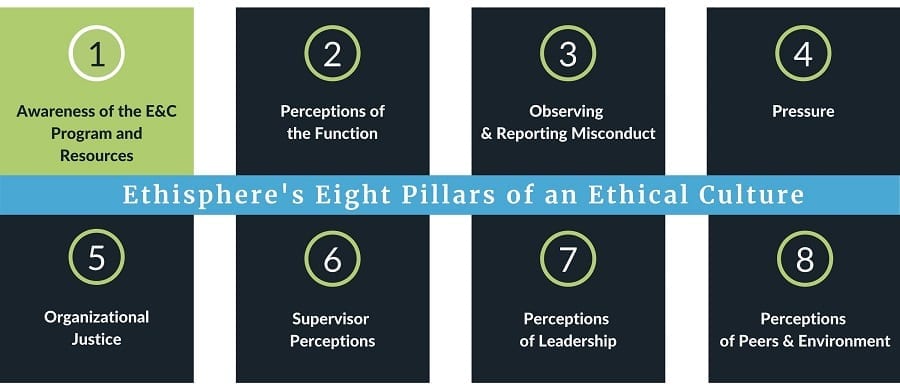AUTHOR:
Scott Stevenson, M.B.A.
Director, Culture Services
Ethics and compliance leaders put tremendous effort into their programs and program effectiveness. The question for many is, ‘is it working?’ Ethisphere’s Ethical Culture assessment has provided this answer to global companies. Now that our data set stands at over a million employee responses (representing the views of more than five million employees), we’re going to use this space to dive into what we measure and what the data is telling us and how you can use these insights to improve your program.
In this series, we share insights into the eight pillars that make up a robust ethical culture. Our eight pillars seek to get at the key metrics of a strong ethical culture: do your employees understand what is expected of them, do they know where to go if they have questions, and if they need help or have made a mistake, do they trust the process enough to ask for it?
In our previous post, we discussed the first marker: do your employees understand what is expected of them. Today’s post focuses on how employees perceive the effectiveness of ethics and compliance communications and training.
PILLAR TWO:
Perceptions of the Ethics and Compliance Function
What we aim to measure:
Perceived quality and program effectiveness of the ethics and compliance function’s efforts in communicating, training and support. In other words, are your efforts reaching the intended audience? Do they see any of the assets you have deployed or are they languishing somewhere on the SharePoint site with no viewers?
Types of questions we ask:
- The company’s training and communication efforts about ethical responsibilities and conduct are effective.
- The company’s other policies effectively explain what is expected of me as I conduct the company’s business.
- The training I receive on ethics and compliance topics effectively explains what is expected of me as I conduct the company’s business.
Why it matters:
Measuring employee understanding of the messaging delivered by the ethics & compliance function is an important step towards figuring out what is – and is not – resonating with employees. These insights can factor into resource plans, communication approach, and prioritization.
What the data says:
This pillar tends to be an area most companies perform well in because of the resources invested in training and communications. The data shows that:
93 percent of employees believe the training on their company’s Code of Conduct was clear and understandable.
87 percent of employees believe their company’s training and communication efforts about ethical responsibilities and conduct are effective.
94 percent of employees believe the Code explains what is expected of them as they conduct the company’s business.
Although these percentages are high, a global company with hundreds of thousands of employees could still have a significant gap. It only takes one unethical employee to cause an issue that could become a reputational disaster.
How Ethisphere clients have used the data/insights:
The demographic analysis can be exceptionally powerful. For example, in working with one global company, ethical culture assessment results showed that across the organization 94 percent of employees believe the code explains what is expected of them. However, that number dipped to 80 percent with employees who have been with the company for 5 to 7 years.
This insight points to the need for additional or new communications or training to the longer-term employees. Our data also shows that managers are where employees most often report concerns. As such, these longer-term employees, who are also more likely to be managers, and could benefit from a short training course or communication so that they better understand the code of conduct and also can educate teams on it as well.
Expert tips for your program effectiveness:
- Use the demographic analysis to identify where employees may be struggling to understand the company’s standards. Perhaps it is by tenure, or business unit, or newly acquired entity.
- Check those insights against other data available to the ethics and compliance function, including click metrics on policies and training completion data. Leverage training resources accordingly.
- Partner with other corporate functions to piggyback on existing efforts and processes that allow for organic delivery of messaging within context of day-to-day operations.
Click here to learn how we can help you communicate the importance of ethical culture in a way that is compelling and accessible.


